Medical expert of the article
New publications
Preparations
Acceptable antibiotics during lactation
Last reviewed: 03.07.2025

All iLive content is medically reviewed or fact checked to ensure as much factual accuracy as possible.
We have strict sourcing guidelines and only link to reputable media sites, academic research institutions and, whenever possible, medically peer reviewed studies. Note that the numbers in parentheses ([1], [2], etc.) are clickable links to these studies.
If you feel that any of our content is inaccurate, out-of-date, or otherwise questionable, please select it and press Ctrl + Enter.
Are there safe antibiotics during lactation? How to take such drugs correctly and what is the risk of their use for mother and child?
Medicines of synthetic or organic origin are antibiotics. They were first used at the beginning of the 20th century and have undergone many transformations over the past decade. Today, there are more than 100 types of antibacterial drugs, which are divided into 11 pharmacotherapeutic groups.
The mechanism of action of antibiotics is aimed at suppressing or destroying pathogenic microorganisms. But there are no universal medications that are equally effective against different bacteria. During lactation, the female immune system works at full speed, but even this is not able to prevent infectious contamination and the development of the inflammatory process.
Antibiotics used during lactation are characterized by a certain effect on the child’s body:
- About 10% of the dose taken penetrates into breast milk. Despite such a minimal volume, most pediatricians do not recommend using drug treatment during lactation.
- Only a doctor can select the safest treatment regimen, individually for each patient. The dosage and duration of the course depend on the pharmacokinetics of the active components, i.e. absorption, distribution and excretion from the body. Considering all these nuances, some medications can be combined with breastfeeding.
- Antibiotics permitted during lactation are included in category A-C. This classifier was developed by the FDA (American Federal Food Commission). The first group includes the most harmless drugs, studies of which were conducted on both animals and humans and showed a positive effect. Medicines from the second and third groups have been tested only on animals, that is, their safety on humans has not been tested.
A nursing mother should take into account the characteristics of each prescribed drug in order to minimize the risk of side effects in the child. It is also necessary to carefully study the instructions for the drug. Since safe antibacterial agents have permission for use in the annotation.
What antibiotics can be taken during lactation?
There are several groups of drugs that are allowed to be used for the treatment and prevention of various diseases in nursing women. Let's take a closer look at what antibiotics can be used during lactation:
- Group A - studies conducted on animals did not reveal any negative impact on the child in the womb and receiving mother's milk with the drug. Similar controlled experiments on pregnant women were not conducted.
- Group B-C – the mechanism of action of the drugs was studied only on animals. No negative effects were found. The beneficial effect of the drug fully justifies the possible risk of side effects and complications.
Based on the above classification, antibiotics are identified whose use is permitted for nursing women.
- Penicillins are the first antimicrobial agents invented by man. This group includes many drugs that are approved both for lactation and for treating children from the first days of their life. When penicillin enters the body, it suppresses pathogenic flora. The volume of penetration into breast milk is about 0.095% of the dose taken. The risk of developing side effects is extremely small, but if they develop, then most often in the form of allergic reactions and short-term diarrhea. From this group, the most commonly prescribed are: Ampicillin, Oxacillin, Ticarcillin, Piperacillin, Amoxicillin.
- Cephalosporins are new generation medications with minimal penetration into breast milk. Non-toxic, they can provoke dysbacteriosis in the child. They cause a decrease in the production of vitamin K, which is involved in the process of hematopoiesis and calcium absorption. The most commonly prescribed are: Cefuroxime, Ceftibuten, Cefazolin, Cefriaxone, Cefepime.
- Macrolides are prescribed for allergic reactions to the previous groups. According to the FDA scale, they belong to group C, that is, the third category. They are used taking into account all potential risks for the mother and baby. Erythromycin, Clarithromycin, Azithromycin, Spiramycin, Midecamycin.
In addition to the above-mentioned drugs, other medications may be used in international practice. For example, in the USA, drugs from the pharmacotherapeutic group of fluoroquinolones are considered absolutely safe during lactation. While in the UK, this group, and especially the fluoroquinolone Ofloxacin, is prohibited. Since it has been established that the drug has a negative effect on the growth of the child and the condition of the interarticular cartilage.
The use of each medication should be dictated by the severity of the disease. If severe infections are treated during lactation, for example, sepsis or meningitis, then antibiotics contraindicated for breastfeeding cannot be avoided. Such antimicrobial drugs include:
- Aminoglycosides – have low penetrating ability. But even their small concentrations can affect the kidneys of a child. This group of drugs has a toxic effect on the optic nerves, hearing organs and vestibular apparatus. Medicines from this group: Streptomycin, Kanamycin, Gentamicin, Netilmicin, Amikacin.
- Sulfanilamides - aggressively affect the child's liver, can provoke the development of nuclear jaundice and other toxic lesions. This group includes: Sodium sulfacyl, Etazol, Biseptol, Streptocide, Sulfadimezine, Phthalazol.
- Fluoroquinolones – this group has controversial clinical studies. In some countries, fluoroquinolones are prohibited during lactation. In the USA, only Ofloxacin is available for use. This category includes: Ciprofloxacin, Norfloxacin, Levofloxacin, Moxifloxacin.
- Lincosamides – their entry into breast milk negatively affects the functioning of the child's intestines. Popular drugs from this group: Lincomycin, Clindamycin.
- Tetracyclines are another controversial antibiotic that requires a balanced approach to prescribing. It has a toxic effect on the mother's body, and in the child it causes bone tissue disorders and worsens the condition of tooth enamel. Tetracycline, Doxycycline.
Only the attending physician can determine the correct course of antibiotic therapy. Taking any medications on your own during lactation is contraindicated.
List of approved antibiotics during lactation
Medicines used during breastfeeding are divided into several groups. Each of the pharmacological categories has a certain effect on the child's body, entering it with mother's milk. Let's consider the list of permitted antibiotics during lactation and the features of their effect on the body of both the mother and the child.
- Penicillins - penetrate into breast milk and can cause intestinal disorders and allergic rashes in the baby.
- Cephalosporins - when they enter breast milk, they cause the same reactions as penicillins.
- Macrolides penetrate into milk, but do not have a negative impact on the child’s body.
- Aminoglycosides - in small quantities penetrate into breast milk and cause intestinal disorders.
- Glycopeptides enter breast milk and provoke reactions of increased sensitivity of the baby to external irritants and gastrointestinal disorders.
- Monobactams penetrate into the child’s body in small quantities, so they must be used with extreme caution.
- Tetracyclines – cause irreversible changes in the development of teeth and skeletal rudiments in children, provoke intestinal disorders, photosensitivity and candidiasis. Contraindicated during lactation.
- Fluoroquinolones/Quinolones – cause disorders of varying severity. Most often they cause problems in the functioning of joints and growth retardation.
- Lincosamides – cause disturbances in intestinal function and increased sensitivity to external irritants.
- Sulfonamides – enter the child’s body during lactation and can cause nuclear jaundice and brain dysfunction.
The effect of antibiotics from the groups Oxazolidinones, Nitroimidazoles, Nitrofurans, Polymyxins, Carbapenems on the body of infants has not been studied. The use of these drugs is not recommended during lactation.
An indicator that an antibacterial agent can be used during breastfeeding is its low level of penetration into milk. Another important indicator is the rapid elimination of the drug from the female body. Also, do not forget about the absence of toxic substances that can negatively affect both the mother and the child.
Modern medicine does not give a clear answer about which antibiotic is safe during lactation. In each specific case, it is necessary to weigh all the risks, assessing the condition of the mother and baby, the individual characteristics of their bodies. Based on this, only a doctor can select an effective and safe treatment regimen.
Indications antibiotics for lactation
Antibiotics, like any other drugs, have certain indications for use. The need for their use is most often associated with inflammatory processes. Many of them can be caused by staphylococcal, streptococcal infections or other harmful microorganisms. Antibacterial drugs during lactation are prescribed in the following cases:
- Infectious and inflammatory lesions of the respiratory tract and lungs.
- Pathologies of the birth canal due to complicated labor process.
- Intestinal infections.
- Mastitis.
- Kidney disease.
- Diseases of the genitourinary system.
Taking medications ensures the normalization of the patient's well-being and accelerates the recovery process. At the same time, the active substances of the medications penetrate into breast milk, so they can affect the child's body. Based on this, all drugs during lactation should be prescribed only by a doctor. Since only a doctor can assess the real threat to the baby and the potential benefit to the mother's body.
 [ 1 ]
[ 1 ]
Release form
Antibiotics permitted during lactation come in different forms. The form of release and its choice depend on the severity of the disease, the doctor's recommendations and ease of use. For the treatment of tonsillitis, bronchitis or sinusitis, the following forms of antibacterial drugs are most often used:
- Oral - tablets, capsules, syrups, solutions, drops. The only drawback of this form of release is that some medications (penicillin, aminoglycosides) are poorly absorbed and are destroyed when they enter the acidic environment of the gastrointestinal tract.
- For intramuscular and intravenous administration - these are ampoules with injections and powders for the preparation of a solution for injections. They are used parenterally and for administration into the internal environments of the body.
In addition to the above forms, antibiotics can be prescribed in the form of drops, ointments, gel or suppositories for rectal/vaginal administration. Regardless of the form of release, after administration, the drug enters the blood and gradually penetrates the affected organs, providing a therapeutic effect.
Pharmacodynamics
The reaction of the organism and affected tissues, organs to the administered drug is pharmacodynamics. It is characterized by the interaction of the antibiotic with harmful microorganisms to achieve biological activity of a certain degree of expression. In this case, the strength, that is, the therapeutic properties of the drugs, are determined by the following factors:
- Dosage and dosage form.
- Composition of the drug and its active components.
- Integrity of the antibiotic at the site of infection.
Let's consider the pharmacodynamics of antibiotics that are most often used during breastfeeding:
- Penicillins.
- They penetrate into breast milk, but in small quantities - less than 0.1%. According to the FDA classification, they belong to group B (clinical studies have not revealed any adverse effects on the child's body).
- They are prescribed when the benefit to the mother is higher than the possible risks to the child. They rarely cause side effects, which manifest themselves as minor skin rashes and gastrointestinal disorders.
- Before using this group of drugs, you should consult with your pediatrician. Since the child may be prescribed probiotics or anti-allergic agents.
- Cephalosporins, monobactams, carbapenems.
- Allowed during breastfeeding and similar in structure to penicillins. According to FDA classification, they are included in group B. They have pronounced antibacterial properties, especially the latest generation of drugs.
- They have low toxicity and practically do not penetrate into breast milk. Due to this, the risk of developing side effects in the child is minimal. Side effects are similar to reactions from penicillins.
- Macrolides, lincosamides.
They penetrate into breast milk in high concentrations, but do not have a negative effect on the child. In rare cases, they cause allergic reactions and intestinal disorders.
- Aminoglycosides.
Ophthalmic forms of the drug are included in FDA group B, and all others are in category D. They are dangerous during lactation, as they have high nephrotoxic and otoxic properties. They can cause complications such as deafness and renal failure.
Pharmacokinetics
The routes of entry, distribution, metabolism and excretion of medicinal components from the body are pharmacokinetics. The duration of each phase determines the effectiveness of an antibacterial agent and any other drug.
Many antibiotics are distributed throughout most organs, tissues and biological fluids. Active components accumulate in the respiratory and urinary systems, intestinal mucosa, and skeletal system. The degree of penetration into breast milk is less than 1%.
The half-life of antibiotics ranges from 1 to 55 hours. This should be taken into account during breastfeeding. Since most drugs are destroyed in the acidic environment of gastric juice, injection forms are often prescribed to achieve a lasting therapeutic effect.
Dosing and administration
The severity of the underlying disease determines the method of administration and dosage of antibiotics during lactation. Medications can only be used as prescribed by a doctor, following these rules:
- It is better to take the antibiotic during or after lactation. Due to this, the amount of active components of the drug that get into breast milk will be significantly less. The frequency of taking the medicine should be compared with the time of feeding the child.
- If the drug needs to be taken once a day, it is better to do it before the evening feeding. If the medicine is prescribed 2 times a day, then the first time it is taken before bedtime, and the second time 12 hours later, that is, in the evening or at night.
- If breastfeeding has been stopped, you should continue to express milk every 3-4 hours. Before starting therapy, you should make a supply of breast milk. It can be stored in the freezer for a month.
- Breastfeeding should be resumed 3-4 days after the end of antibiotic therapy.
During therapy, it is not allowed to independently change the dosage or treatment regimen prescribed by the doctor. This will reduce its effectiveness, which may lead to complications of the disease and require additional treatment.
Antibiotics for sore throat during lactation
Angina is an acute bacterial disease with damage to the tonsils. Most often it occurs due to streptococcal infection, viruses, fungi, bacteria. Antibiotics for angina during lactation are necessary not only to treat the disease, but also to prevent its serious complications. Therapy is carried out after consultation with a doctor, since only a specialist can make a correct diagnosis and select safe but effective drugs.
If acute tonsillitis is mild or moderate, Amoxiclav tablets are used as antibacterial agents. In case of penicillin intolerance, Erythromycin, Azithromycin or Vilprafen are prescribed. If the pathology is severe, injectable antibiotics are prescribed.
Effective antibiotics for sore throat during lactation:
- Amoxiclav
Antibacterial combination drug. Contains two active components: amoxicillin and clavulanic acid. The first is a broad-spectrum antibiotic, and the second is an inhibitor of microorganism beta-lactamases. The drug is active against many harmful microorganisms, viruses and bacteria.
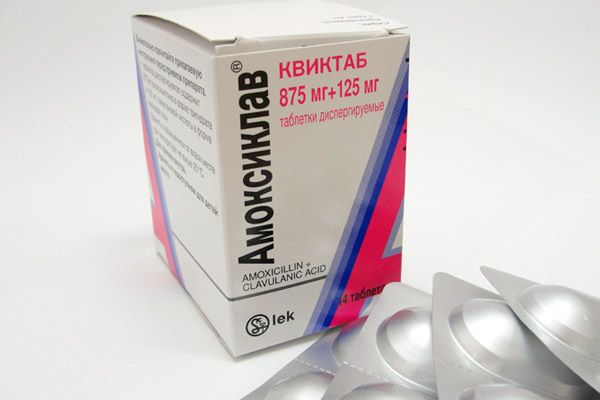
- Indications for use: pneumonia, acute and chronic sinusitis, bronchitis, urinary tract infections, otitis, retropharyngeal abscess, gynecological infections and soft tissue lesions, gonorrhea, periodontitis and odontogenic infections, prevention of purulent-septic complications, mixed infections.
- It has several forms of release: tablets for oral administration of 250-500 mg amoxicillin/125 mg clavulanic acid with an enteric coating, powder for the preparation of a suspension for oral administration, powder for the preparation of a solution for parenteral administration. Tablets are taken before meals with water, the dose is selected individually for each patient. The course of treatment is 5-14 days.
- Side effects are mild and temporary. Most often, patients experience the following reactions: nausea, diarrhea, dyspepsia, vomiting, flatulence, change in urine color. Allergic reactions, dizziness and headaches, hepatobiliary disorders, and urinary system disorders are also possible.
- Contraindications: hepatitis, individual intolerance to the components of the drug, cholestatic jaundice. In case of overdose, insomnia, dizziness, increased agitation, convulsions appear. Treatment is symptomatic, hemodialysis is possible.
- Ampicillin
Semi-synthetic antibiotic, active against gram-positive microorganisms and a number of gram-negative ones. Not destroyed in the acidic environment of the stomach. Effective in diseases caused by mixed infection.

- Indications for use: pneumonia, bronchopneumonia, lung abscesses, tonsillitis, peritonitis, cholecystitis, sepsis, intestinal infections, gonorrhea, soft tissue lesions and other infections caused by microorganisms sensitive to the drug.
- Method of application: the drug is available in the form of oral tablets and powder for suspension. Single dose 500 mg, daily 2-3 g. The daily dose is divided into 3-6 doses. The duration of therapy depends on the severity of the disease, usually 5-10 days, but not more than 2-3 weeks.
- Side effects: allergic rashes, gastrointestinal disorders. To eliminate them, it is necessary to stop taking the drug and conduct desensitizing therapy.
- Contraindications: penicillin intolerance, liver failure, allergic diseases, bronchial asthma, hay fever.
- Cefadroxil
A semi-synthetic cephalosporin antibiotic produced in capsule form. It has bactericidal properties and is active against a wide range of harmful microorganisms.
- Indications for use: lower respiratory tract infections, bronchitis, pneumonia, urinary tract infections, soft tissue, bone and joint infections, otitis, sinusitis, pharyngitis, tonsillitis.
- Method of use and dosage: capsules are taken orally, regardless of food, with water. Dosage 1-2 g per day, divided into several doses. Duration of therapy is 7-10 days.
- Side effects: gastrointestinal disorders, nausea, vomiting, diarrhea, allergic skin rashes, headaches and dizziness, insomnia, growth of opportunistic microorganisms.
- Contraindications: hypersensitivity to active components. Use with special caution during pregnancy and lactation.
- Overdose: nausea, vomiting, headaches and dizziness, loss of consciousness. Gastric lavage and hemodialysis are indicated for treatment. During treatment, milk should be expressed and not used. Lactation can be restored 2 days after the end of therapy.
- Cefazolin
A drug with a broad spectrum of bactericidal action. Active against gram-positive and gram-negative microorganisms. Available in powder form for injection solution.
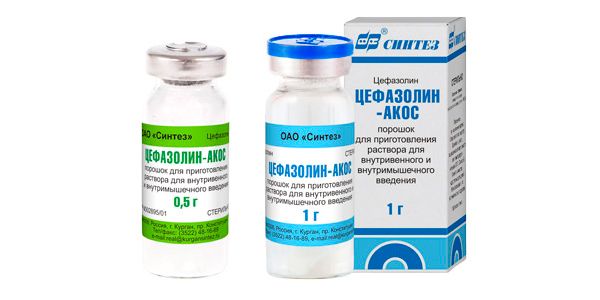
- Indications for use: pneumonia, lung abscesses, pleural empyema, urinary tract infections, musculoskeletal infections, skin and soft tissue infections, peritonitis and other diseases caused by microorganisms sensitive to the drug.
- Method of administration: the medicine is administered intravenously and intramuscularly. The dosage and duration of treatment is determined by the attending physician, individually for each patient. The daily dosage should not exceed 1-4 g.
- Side effects: skin allergic reactions, transient increase in liver aminotransferase levels. Gastrointestinal disorders, dysbacteriosis, superinfection, local reactions due to intramuscular administration, phlebitis with intravenous administration.
- Contraindications: intolerance to the components of the drug, pregnancy, newborns.
- Overdose: dizziness, headaches, paresthesia, convulsions, vomiting, increased heart rate. Symptomatic therapy and hemodialysis are indicated for treatment.
- Erythromycin
An antimicrobial drug that is similar in its spectrum of action to penicillins. It is active against gram-positive and gram-negative pathogens. It is available in the form of 100-250 mg tablets with an enteric coating and 1% ointment.
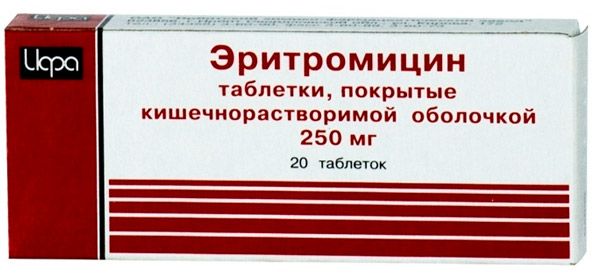
- Indications for use: pneumonia, pneumopleurisy, infectious lung lesions, septic conditions, erysipelas, mastitis, osteomyelitis, peritonitis, purulent-inflammatory processes, sepsis.
- Method of administration: a single dose is 250 mg, in particularly severe cases 500 mg is prescribed. The medicine is taken every 4-6 hours 1-1.5 hours before meals. With prolonged use of the drug, resistance to it may develop.
- Side effects: nausea, vomiting, diarrhea, liver dysfunction, allergic reactions.
- Contraindications: intolerance to active components, severe liver dysfunction, history of allergic reactions.
According to the instructions, the above antibiotics are not recommended during lactation. But it is necessary to take into account that this contraindication is not absolute. The doctor takes into account the state of the mother and child, the course of the disease. Based on this, the dosage and duration of treatment are selected. The course of therapy usually takes 7-14 days. If necessary, its duration can be extended. At the same time, it is forbidden to stop taking the prescribed drugs on your own, since very often this leads to serious complications and even death.
Local treatment of sore throat is ineffective. Since gargling solutions, compresses or lozenges do not create the necessary concentration of active components to destroy pathogens. Such procedures can be used as an addition to the main therapy.
Auxiliary means for the treatment of acute tonsillitis during breastfeeding:
- Rinsing - should be done when the first symptoms of the disease appear. They help prevent the development of purulent complications. Of the pharmaceutical preparations, nursing mothers are allowed to take Furacilin solution, calendula and eucalyptus tincture, Miramistin, Chlorhexidine, Iodinol. Also, for rinsing, you can use chamomile and sage infusion, garlic infusion, aloe juice with Kalanchoe and honey, carrot or beetroot juice.
- Lozenges, sprays, inhalations - before using them, you need to rinse your throat well so that the infection does not get into the digestive tract. Inhalations can be done with mineral water or saline. Of the lozenges and lozenges with antiseptics, the following are recommended: Septolete, Lizobact, Strpsils, Trachisan. It is also allowed to use Stopangin, Kameton spray, Solin or Aquamaris sea salt solutions.
During the treatment of angina, it is very important to monitor the child's condition. Despite the relative safety of the main antibacterial drugs, their use can provoke digestive disorders, abdominal pain and colic, anxiety, various allergic rashes on the body in the baby. If such symptoms appear, you should consult a doctor. Since stopping antibiotics is not recommended, the doctor may prescribe other drugs or stop lactation for a while.
 [ 20 ], [ 21 ], [ 22 ], [ 23 ]
[ 20 ], [ 21 ], [ 22 ], [ 23 ]
Antibiotics for bronchitis during lactation
Inflammation of the bronchial walls caused by viral, bacterial or fungal infections is bronchitis. Infection occurs both by contact and airborne droplets. Antibiotics for bronchitis during lactation are necessary for the effective elimination of pathogens and to prevent possible complications. The female body is weakened after childbirth, so it is more susceptible to various infections.
Bronchitis can occur in acute and chronic forms. The first lasts about 10 days, accompanied by flu or cold symptoms. Treatment depends on the pathogen:
- If a viral infection is detected, antiviral agents are used. Most often, interferon inducers are prescribed, which stimulate the production of proteins that suppress the growth and development of viruses.
- In case of bacterial bronchitis, antibacterial drugs are used. The type of medication and its dosage are selected by the attending physician, individually for each patient. During breastfeeding, semi-synthetic penicillins, macrolides or cephalosporins are most often used.
- If bronchitis is caused by a fungal infection, then therapy is based on the use of antifungal drugs. Expectorants that clear the bronchi are prescribed without fail.
Broad-spectrum antibiotics are effective in treating all forms of bronchitis. But they are prescribed if a blood test shows signs of bacterial infection, the woman has had a high temperature for several days, shortness of breath has appeared, and phlegm has become abundant.
Most often, patients with bronchitis are prescribed the following antibiotics:
- Amoxicillin
A bactericidal antibiotic from the group of semi-synthetic penicillins. Has a broad spectrum of action. Acid-resistant, quickly and completely absorbed in the intestine. Available in the form of tablets for oral administration with an enteric coating, oral solution and suspension, dry substance for injection.
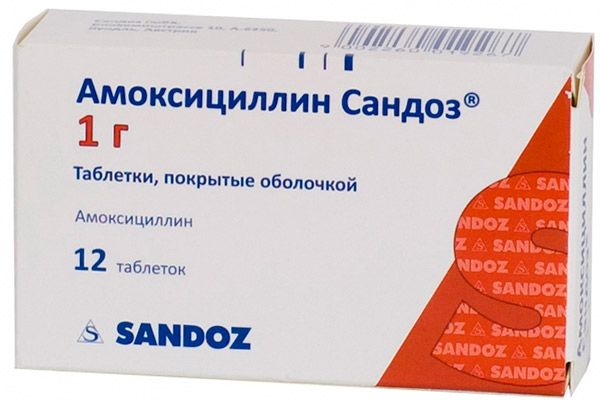
- Indications for use: bronchitis, pneumonia, pyelonephritis, tonsillitis, urethritis, colienteritis, gonorrhea and other diseases caused by microorganisms sensitive to the drug. Dosage and duration of treatment depend on the doctor's prescription.
- Side effects: various allergic reactions, rhinitis, conjunctivitis, joint pain, fever. In rare cases, superinfection may develop. Cross-allergic reactions with cephalosporin antibiotics are also possible.
- Vilprafen Solutab
An antibiotic from the macrolide group, has bacteriostatic properties. Getting into the inflammation site, it creates high concentrations of the active component, providing a bactericidal effect. The drug is available in the form of enteric-coated tablets and a suspension for oral administration.
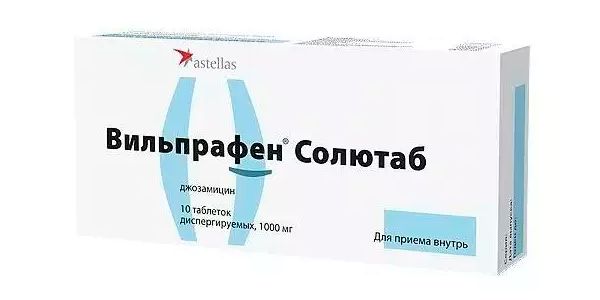
- Indications for use: upper respiratory tract and ENT infections, lower respiratory tract infections, oral infections, scarlet fever, diphtheria, skin and soft tissue infections, genital and urinary tract infections.
- Method of administration: 1-2 g in 2-3 doses. Duration of treatment is 5-10 days. The use of increased doses causes overdose symptoms. This is manifested by gastrointestinal disorders: nausea, vomiting, diarrhea.
- Side effects: heartburn, vomiting, dysbacteriosis, impaired bile flow, allergic skin reactions, dose-dependent hearing impairment, candidiasis.
- Contraindications: hypersensitivity to macrolides, severe liver dysfunction. Use with caution during pregnancy and lactation.
- Spiramycin
Macrolide antibiotic with bacteriostatic properties. Has a broad spectrum of action. Available in the form of enteric-coated tablets.
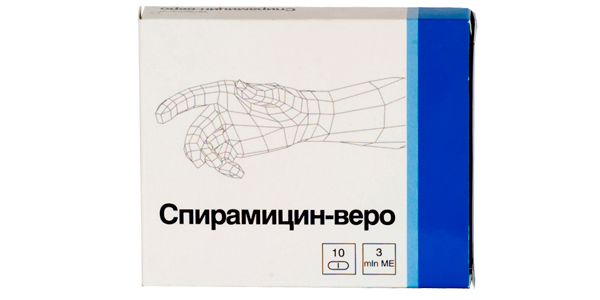
- Indications for use: bronchitis, pharyngitis, atypical pneumonia, osteomyelitis, soft tissue infections, prostatitis, toxoplasmosis, tonsillitis, urethritis, sinusitis, gynecological pathologies, otitis, prevention of infectious diseases of the ENT organs, urinary tract and meningococcal infection. The drug is taken 1 tablet 3 times a day. Duration of treatment is 5-7 days.
- Side effects: skin allergic reactions, itching, diarrhea, nausea, pain in the epigastric region, paresthesia, ulceration of the gastrointestinal mucosa, vomiting, pseudomembranous colitis. Overdose is manifested by similar symptoms. There is no antidote, so symptomatic therapy is indicated.
- Contraindications: allergic reactions to the components of the drug. Use with special caution during lactation, liver failure and obstruction of the bile ducts.
The duration of treatment and the dosage of the drugs prescribed by the doctor depend on the form and stage of the disease. The child's reaction to the antibiotic is also taken into account. Taking such drugs on your own is contraindicated.
What antibiotics can be used during lactation with sinusitis
Sinusitis is an inflammation of the paranasal sinuses. In 75% of cases, the disease develops due to advanced acute respiratory viral infection or rhinitis. According to medical statistics, every tenth sinus lesion is caused by an untimely visit to the dentist. During pregnancy and lactation, this problem is especially relevant, since hormonal changes lead to a violation of the water-electrolyte balance and an exacerbation of dental problems and chronic pathologies of the nasopharynx.
The disease is characterized by the following symptoms: severe headaches, thick purulent discharge from the nose, high temperature, heaviness. What antibiotics can be used during lactation with sinusitis can only be determined by a doctor after a full diagnosis. This is due to the fact that the disease can be caused by many bacterial agents, ranging from Haemophilus influenzae to Staphylococcus aureus. Diagnosis is carried out using a nasal smear and a microbiological laboratory. This will determine the most suitable antibiotic.
Most often, the following antibacterial drugs are prescribed for the treatment of sinusitis:
- Azithromycin
A broad-spectrum antibiotic. Belongs to the pharmacological group of macrolides. Active against gram-positive and gram-negative microorganisms. Available in the form of tablets, capsules and syrup in a bottle for oral use.

- Indications for use: infectious diseases caused by microorganisms sensitive to the drug, sore throat, bronchitis, sinusitis, tonsillitis, scarlet fever, pneumonia, skin and soft tissue infections, Lyme disease, genitourinary tract infections.
- The medicine is taken 1 tablet 2-3 times a day, the course of treatment is 5-7 days.
- Side effects: nausea, diarrhea, abdominal pain, increased activity of liver enzymes, skin rashes.
- Contraindications: intolerance to macrolide antibiotics. It is prescribed with special caution during pregnancy and lactation, allergic reactions in the anamnesis, in case of severe liver and kidney dysfunction.
- Augmentin
A broad-spectrum antibacterial agent. Active against aerobic, anaerobic, gram-positive and gram-negative microorganisms. Contains clavulanic acid and amoxicillin. Available in tablet form, syrup, dry substance for suspension and powder for injection.

- Indications for use: acute and chronic bronchitis, lobar bronchopneumonia, empyema, lung abscesses, genitourinary tract infections, sepsis, tonsillitis, sinusitis, pharyngitis, peritonitis, pelvic infections, osteomyelitis, postoperative infectious complications.
- Method of application: the dosage and course of treatment depend on the form of the drug and the severity of the disease. Tablets are prescribed 3 times a day at 375 mg (1 capsule), if the infection is severe, the dosage can be doubled.
- Side effects: digestive disorders, skin allergic reactions, headaches and dizziness, liver dysfunction, hyperemia of the mucous membranes. In case of overdose, these reactions become more pronounced. To eliminate them, it is necessary to stop taking the drug, conduct symptomatic therapy and seek medical help.
- Contraindications: hypersensitivity to the components of the drug, allergic reactions in the anamnesis. With special caution and only under medical supervision is used during pregnancy and breastfeeding.
- Cephalexin
A semi-synthetic antibiotic from the pharmacotherapeutic group of 1st generation cephalosporins. It has bactericidal properties and a broad spectrum of action. It is quickly absorbed from the gastrointestinal tract, penetrates into all organs, tissues and body fluids. It has several oral forms of release: capsules, tablets, powder for suspension.

- Indications for use: bronchitis, pneumonia, pleurisy, lung abscess, ENT infections, infectious lesions of the urinary system and skin, osteomyelitis, arthritis. The drug is prescribed in a dosage of 1-4 g, but if the disease is caused by gram-negative flora, the dose can be increased to 4-6 g. The course of treatment is 7-14 days.
- Side effects: dyspepsia, diarrhea, pseudomembranous colitis, increased weakness, blood count disturbances, dizziness, allergic reactions of varying severity.
- Contraindications: individual intolerance to antibiotics of the penicillin series and cephalosporins. The possibility of cross-allergy is necessarily taken into account.
- Ceftriaxone
A 3rd generation cephalosporin antibiotic. It has a bactericidal effect by inhibiting the synthesis of bacterial cell walls. It has a broad spectrum of antimicrobial action, affects aerobic, anaerobic, gram-positive and gram-negative microorganisms. It is available in the form of powder for injection.
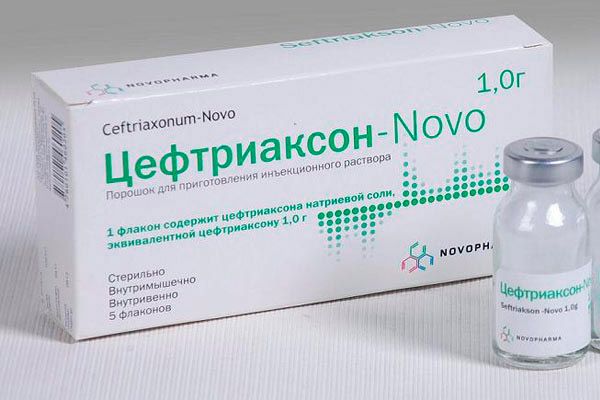
- Indications for use: infections of the ENT organs, upper and lower respiratory tract, skin and soft tissues, infections of the abdominal organs, sepsis and bacterial septicemia, bacterial meningitis and endocarditis, salmonellosis, prevention of postoperative purulent-septic complications.
- Method of administration: the medicine is used for intramuscular and intravenous injections. Only freshly prepared solutions may be used. For intramuscular administration, 500 mg of the drug is dissolved in 2 ml of water, for intravenous administration, in 5 ml of water or 1 ml of solvent. The daily dose of the active component should not exceed 2 mg.
- Side effects: nausea, vomiting, bowel disturbances, transient increase in liver transaminase activity, cholestatic jaundice, allergic skin rashes, blood count abnormalities, phlebitis, pain at the injection site, candidiasis.
- Contraindications: hypersensitivity to the components of the drug, penicillins and other cephalosporins, pregnancy and lactation, hepatic and renal failure.
- Overdose occurs with prolonged use of the drug or the use of increased dosages. It manifests itself as leukopenia, neutropenia, hemolytic anemia and other disorders of the blood picture. Treatment is symptomatic.
When choosing medications, it is necessary to take into account that most effective drugs are contraindicated for nursing women. This is due to the fact that antibiotics penetrate into all structures of the body, including breast milk. Strong drugs can cause gastrointestinal disorders in a child, allergic reactions and even fungal lesions of the mucous membrane.
In addition to tablets, saline solutions for rinsing the nose may be prescribed for treatment. Most often, Marimer, Dolphin or Quix are used. These drugs clear the nose and sinuses of pus and mucus. Vasoconstrictor drops may also be used for treatment, but when using them, it is very important not to exceed the daily dosage: Nazivin, Galazolin, Tizin.
If long-term treatment of sinusitis does not lead to positive results, this may indicate the presence of cysts or polyps in the nasal sinus. In particularly severe cases, surgical intervention is possible. The ENT specialist performs a puncture of the maxillary sinus. This procedure is performed on an outpatient basis and does not require stopping lactation.
Contraindications
The main contraindications to the use of antibiotics during lactation:
- Allergic reactions.
- Individual intolerance to the active components and other components of the drug.
- Hepatic and renal failure.
If the above contraindications are present, it is necessary to stop lactation during therapy.
Side effects antibiotics for lactation
Antimicrobials used to treat breastfeeding women can cause side effects in both mother and child. Most often, patients experience the following symptoms:
- Allergic reactions.
- Disorders of the digestive system.
- Intestinal dysbacteriosis.
- Toxic effect on the liver and hematopoietic system.
To eliminate the above-described reactions, it is necessary to stop lactation and conduct symptomatic therapy for the patient and the infant.
Overdose
Failure to follow doctor's recommendations for the use of antimicrobial drugs during breastfeeding can lead to various adverse symptoms. Antibiotic overdose manifests itself in different ways and depends on which drug was used:
- Overdosing on penicillins and cephalosporins causes nausea, vomiting, and bowel disorders. Ingestion of large doses may cause epileptic seizures.
- Tetracyclines are the most dangerous for both mother and child. They provoke pain in the epigastrium, nausea, vomiting, and skin allergic reactions.
- Overdose of aminoglycosides is not life-threatening. If these drugs are used in ophthalmological practice, they can worsen neuromuscular blockade.
- Overdose of fluoroquinolones manifests itself through pathological effects on the cardiovascular system. Renal failure, damage to joints and tendons, and intoxication of the body may also develop.
- Sulfanilamides cause nausea and allergic reactions. In rare cases, cerebrovascular accidents are observed.
To eliminate painful symptoms, there are certain methods of removing active components from the body. First of all, this is bowel cleansing with enterosorbents. Symptomatic therapy should be started with the appearance of the first signs of overdose. Particular attention should be paid to maintaining water and electrolyte balance.
Interactions with other drugs
The number of antibacterial drugs increases every year. Therefore, all possible interactions with other drugs should be carefully monitored by the attending physician. Since the combination of some drugs can cause various adverse symptoms, both in the mother and in the child.
Main interactions:
- Amoxiclav – inactivates aminoglycosides and potentiates the action of indirect anticoagulants.
- Ampicillin - injection forms of the drug are contraindicated to be mixed in a syringe with other medications.
- Cefazolin - when used simultaneously with probenecid, the concentration of cefazolin in the blood plasma increases.
- Spiramycin – increases metabolism and reduces the activity of oral contraceptives, anticoagulants, glucocorticosteroids.
- Erythromycin is contraindicated for use with lincomycin, theophylline, acetylcysteine.
In complex treatment using several drugs simultaneously, it is necessary to take into account the risk of developing synergistic and antagonistic interactions. This may affect the effectiveness of treatment.
Storage conditions
Since antibiotics used during lactation may have different forms of release, it is necessary to observe their storage conditions. Tablets, capsules and dry powders for oral use should be kept in the original packaging, protected from sunlight and inaccessible to children. The recommended storage temperature is 25 ° C. Injections can be stored at room temperature, ready-made solutions should be used on the day of their preparation.
Shelf life
Antibacterial drugs have different expiration dates, which depend on the form of the drug and its composition. Tablets and capsules must be used within 24-36 months from the date of manufacture. The expiration date of injections and other drugs, including those for local use, is indicated on their packaging. Taking expired medications is contraindicated.
 [ 40 ]
[ 40 ]
How to restore lactation after antibiotics?
Many young mothers who undergo antibiotic therapy are faced with the question: how to restore lactation after antibiotics. During treatment, it is necessary to take into account the fact that temporary use of drugs is not always an indication for stopping breastfeeding. Even without putting the baby to the breast, lactation can be maintained. To do this, you must adhere to the following rules:
- Express milk as often as the baby takes the breast, preferably every 3-4 hours.
- Express milk at night. This promotes the production of the hormone prolactin, which maintains lactation.
- Use only high-quality breast pumps for expressing milk.
- Drink plenty of fluids, eat well and rest.
If antibiotics are prescribed on a planned basis, it is necessary to prepare a supply of milk in advance by freezing it. If this is not done, then due to a break in lactation, the infant will have to be transferred to nutritious milk formulas. When deciding to stop lactation during treatment, it is necessary to take into account the age of the child. Since for babies under 6 months, mother's milk is the best food.
It is impossible to restore lactation immediately after antibiotics. It is resumed after 2-4 days. The woman should drink intestinal sorbents for a couple of days, such as Pelifepan, Enterosgel or Sorbogel. They promote the complete removal of drug residues from the body and allow breastfeeding to be resumed.
Antibiotics during lactation, taken without a doctor's prescription, can cause adverse reactions. Painful symptoms affect both the mother and the child. Correct antibiotic therapy prescribed by a doctor practically does not cause negative consequences and allows for full treatment.
Attention!
To simplify the perception of information, this instruction for use of the drug "Acceptable antibiotics during lactation" translated and presented in a special form on the basis of the official instructions for medical use of the drug. Before use read the annotation that came directly to medicines.
Description provided for informational purposes and is not a guide to self-healing. The need for this drug, the purpose of the treatment regimen, methods and dose of the drug is determined solely by the attending physician. Self-medication is dangerous for your health.

